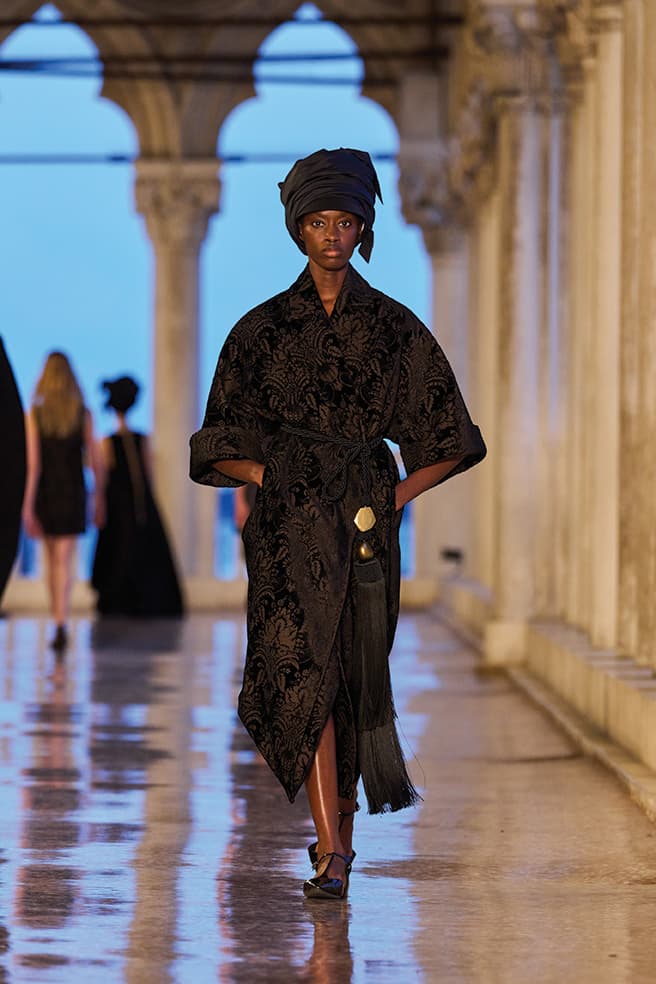The Road to Renaissance to Runway
- Magazine Article
- Exhibitions
Planning a Fashion Exhibition

Ensemble, resort 2025. Ian Griffiths (British, b. 1963) for Max Mara (Italy, est. 1951). Burned silk velvet bonded with sable wool. Max Mara. Photo: Vogue. © Condé Nast
When conceiving any curatorial project, including a major fashion exhibition like Renaissance to Runway: The Enduring Italian Houses, hurdles arise, from deciding on narratives to reconciling a meandering object checklist. Take a look behind the scenes at my journey on the road to Renaissance to Runway, opening at the CMA in fall 2025.
One important part in planning this exhibition has been delineating the historical periods that the show examines, as referenced by 20th- and 21st-century Italian fashions. After gleaning endless examples of ensembles and accessories featuring references to early modern art, I found that the most articulate creative silhouettes look to Renaissance, Mannerist, and Early Baroque art and cultural expressions from between 1400 and 1630.
Many Italian fashion houses and designers from the past century use a methodology that conflates references from the early modern period to underpin a concept of Italian creative values. Emphasizing the historical period of analysis, we can home in on early modern artworks, including key examples from the CMA’s collection, to be in dialogue with the 20th- and 21st-century fashions in the exhibition. For example, the exhibition presents a Max Mara floral-patterned coat dress that is made of a silk velvet fabric, in which the voided areas create a height juxtaposition to the raised velvet pile. This ensemble is presented alongside the CMA’s sumptuous Venetian procurator’s stole from the late 1500s, which has a double-pile velvet. The pairing illuminates Max Mara’s contemporary techniques that look to historical weaving composition in early modern Italy. The show also includes a beautiful silk taffeta gown designed by Roberto Capucci in 1989, bedecked with floral embroideries. Its refined, elegant silhouette brings to mind the amplification of flowers and foliage as beautifying elements in early modern art aesthetics, as evidenced in Botticelli’s 1480 painting Primavera, an image of which is included in the show.
Another unique challenge of planning Renaissance to Runway has been setting an official checklist. It’s hard to decide among many beautiful and relevant fashions what to include! The difference between desires and reality must be reconciled without sacrificing the exhibition’s goals, where the creation of the most accessible juxtapositions between fashions and artworks is of primary importance. Fashions that are too complicated to visually dissect can disrupt a viewing experience. As most major global fashion exhibitions require loans from a series of lenders, including other museums, private collections, research centers, and, of course, fashion house archives, negotiations are complex and ongoing. But Renaissance to Runway has already secured loans to present fashions from leading Italian houses, such as Versace, Pucci, Ferragamo, Max Mara, Giorgio Armani, and more, and we look forward to confirming and sharing even more details.
Though much of this planning can happen from Cleveland, some steps are better worked out abroad. To obtain the loans in my previous exhibition, Korean Couture: Generations of Revolution, I traveled to Seoul to get to know the designers and their respective culture, immersing myself in their lived experiences to enrich the research. Renaissance to Runway is no different. Visiting fashion-house headquarters from Milan to Florence to Rome to consult with archival teams and designers has allowed me to add texture to the exhibition and confirm my curatorial findings. Italian art museums can also help contribute to the art historical research framing many of the fashions. These visits help satisfy the requirements of negotiations that entail thoroughly comprehending each house’s aesthetics and presenting to the lenders how their archival designs fit the exhibition themes.
There is much to anticipate at this point. An exhibition catalogue is underway featuring fabulous illustrations alongside photos of fashions from the exhibition, shot this spring in Milan. The photographer, Luca Stoppini, was the former creative director of VOGUE Italia, where he worked alongside editor-in-chief Franca Sozzani before her passing in 2016. We are also collaborating with Sozzani’s son, photographer Francesco Carrozzini, to create an expansive digital installation that fuses the works in the exhibition with a dynamic interactive landscape.
During my visits to Italy, I came to see that fashion is often a family business. The houses of Missoni, Ferragamo, Versace, Etro, and others were and sometimes still are operated by the families who founded each company. Even in the early modern period, textile guilds were family operated, and powerful aristocratic families dictated fashion trends of the time. So, one could say that aspects of Italian style are built on family values. Renaissance to Runway is a love letter to Italy's incredible artistic ingenuity that has continuously captured the world’s heart and imagination. We hope you share our anticipation for it with your own family and friends as we look forward to the exhibition this fall.